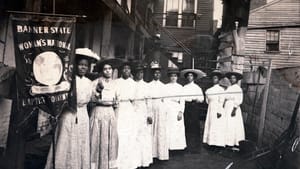Stay in the Loop
BSR publishes on a weekly schedule, with an email newsletter every Wednesday and Thursday morning. There’s no paywall, and subscribing is always free.
Seeing suffragists
The Brandywine River Museum of Art presents ‘Votes for Women: A Visual History’

Entering the Brandywine River Museum of Art’s Votes for Women: A Visual History exhibition, I was eager to immerse myself in the fight for women’s liberation and political inclusion throughout the 19th and early 20th centuries. As an American-born woman, I was prepared to encounter artifacts of the US suffrage movement, and the women who mobilized it and continue to inspire activism today. But as a woman of color, I was also prepared for the possibility that, as with many representations of American history, WOC would be erased or misrepresented in the retelling of world events.
Mentally prepared to be both awed and disappointed, I faced the exhibit entrance. Here, in bold letters, the 19th Amendment welcomes visitors.
What we saw
In today’s world, we can tune in on various devices, platforms, and outlets to connect, organize, and stay informed. Social media, along with revolutionized digital and print media, make it easy to discover, become inspired by, and rally alongside young (women) activists like Emma González, Amariyanna Copeny, and Greta Thunberg, to name a few.
Visual communication has evolved in momentous ways in the 21st century, and as the year 2020 marks the 100th anniversary of the 19th Amendment to the US Constitution, the Brandywine Museum’s promise to offer an exhibition that “rediscovers the visual language of the women’s suffrage movement” is an apt one.
What I didn’t know
I anticipated viewing documents and images I’ve already seen over years of learning about the suffrage movement and suffragists. Maybe I’d learn a new detail or two about the movement and get some deeper insight into who some of the suffragists were and how else they were involved. However, my ignorant thought that I knew most of the complex history of the US suffrage movement was immediately washed away.
The exhibition houses replicas of posters, magazine covers, postcards, illustrations, photos, paintings, buttons, banners, patches, flags, various items of strategically stylized clothing, and playbills—yup, suffrage supporters utilized local theaters to curate plays to relay their messages to members of their communities and local politicians, and several of these playbills and related ephemera, along with details about each play, are on display here. *inhales deeply* These incredible artifacts are all visual representations of the ways the suffragists communicated their political messages in their everyday interactions with other members of the movement, families, people within their communities, and politicians.

Due diligence for all women
While the exhibit celebrates the 19th Amendment and the efforts of many to bring it to fruition, I found myself reviewing many displays that highlight and remember the struggles that continued for marginalized people long after the amendment was passed—Black, Indigenous, immigrant, and working-class women throughout and after the US suffrage movement in the 19th and early 20th centuries. Votes for Women not only mentions WOC and other marginalized women within the context of their roles alongside white suffragists, but also respectfully features them in illustrative portraits that make up a large, informative mural, created by five women artists and titled Hidden Figures of the Suffrage Movement.
It’s clear to me that curator Amanda C. Burdan has done her due diligence, ensuring that within the realm of existing artifacts and imagery, the exhibit represents the whole picture of this American liberation movement. Votes for Women: A Visual History is a pleasing and empowering experience that highlights the many inventive and resourceful ways suffragists communicated, organized, promoted, protested, and advocated for women’s liberties and rights more than a century ago, and it makes me appreciate the ways we can use similar tools to mobilize our continued efforts for unity, freedom, and justice.
What, When, Where
Votes for Women: A Visual History. Through June 7 at the Brandywine River Museum of Art, 1 Hoffman’s Mill Road, Chadds Ford, PA. (610) 388-2700 or brandywine.org/museum.
The Brandywine River Museum is an ADA-compliant venue. Find more info on accessibility here.
Sign up for our newsletter
All of the week's new articles, all in one place. Sign up for the free weekly BSR newsletters, and don't miss a conversation.

 Olivia J. B. Baxter
Olivia J. B. Baxter